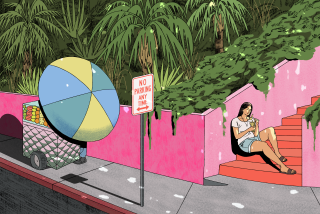Redemption From <i> La Vida Loca</i> : Only a broad and intense community effort will stem gangs’ growth
- Share via
The street gang problem hits close to home for many Angelenos--not just residents of the neighborhoods that gangs stake out as their turf but the many others who avoid certain parts of town that are perceived as gang-infested and dangerous. That fear--and the reason for such thinking--must be eliminated if this region is ever to view itself as a real community instead of a sprawl of neighborhoods alien to each other and sometimes at war. Only when each person is seen as a valuable being, and not just some nameless throwaway, can a spirit of solidarity grow.
To help put a human face on a single statistic in the record of L.A. gang activity, today’s Opinion section is publishing a powerful photo essay that chronicles the short life--and violent death--of Javier Ortega Martinez, 18, known as Boomer to his compatriots in an L.A. street gang.
In many ways Boomer was typical of the youths drawn to gangs--an unemployed school dropout who drifted away from home and used the gang as a surrogate family. Perhaps these sad photos will communicate in a fundamental way the need to ameliorate the social conditions that led to Los Angeles’ record 771 gang-related homicides in 1991.
An essay by poet Luis Rodriguez--himself a street gang survivor who moved his family to Chicago to escape his L.A. connections--offers further context. He writes powerfully of his struggle to keep his stepson out of the same cycle--strong stuff, but hopeful because Rodriguez is living proof of redemption from la vida loca .
Though to a considerable degree breaking away from a street gang is a personal choice--and, obviously, some gang members are hard-core criminals beyond redemption--there are private and public programs that can help. Most, sadly, do not get nearly enough financial support. Some, like Victory Outreach, base their appeal on religion. Others, like Hollenbeck Youth Center, do it with sports. Some, like former football great Jim Brown’s Amer-I-Can program, use ethnic pride to build self-esteem.
This newspaper has in particular endorsed two anti-gang programs first promoted by the church-based community groups affiliated with the Industrial Areas Foundation. The Community Youth Gang Services Project hires mature ex-gang members, trains them in crisis intervention and puts them on the streets to try to prevent gang violence. A new program, Hope in Youth, will put specialists, social workers and teachers into neighborhoods to keep kids out of gangs by helping them in school, finding jobs and fostering communication with families.
As Rodriguez’s essay points out, some gangs have been around for generations and will not go away overnight. But they can be overcome, eventually, if those of us on the outside help provide the education, jobs and simple respect that all young people want. Society must try to save youngsters who are attracted to gangs before that lifestyle becomes embedded--and possibly a deathtrap.
More to Read
Sign up for Essential California
The most important California stories and recommendations in your inbox every morning.
You may occasionally receive promotional content from the Los Angeles Times.










